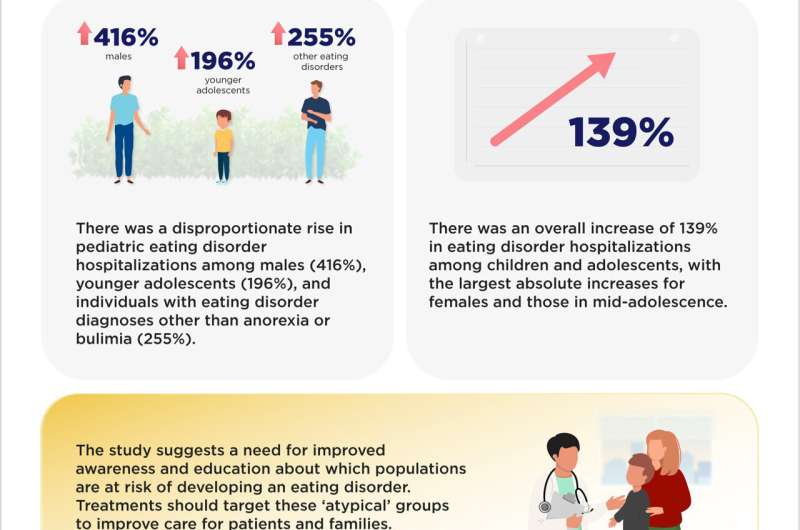This article has been reviewed according to Science X's editorial process and policies. Editors have highlighted the following attributes while ensuring the content's credibility:
fact-checked
peer-reviewed publication
trusted source
proofread
Eating disorder hospitalizations on the rise in Canada, affecting 'atypical' groups the most: Study

There was a disproportionate rise in pediatric eating disorder hospitalizations among males, younger adolescents, and individuals with eating disorder diagnoses other than anorexia or bulimia, according to a new study from researchers at The Hospital for Sick Children (SickKids) and ICES.
This large, population-based study spanned a 17-year period in Ontario, Canada (2002–2019), and tracked an overall increase of 139% in eating disorder hospitalizations among children and adolescents, with a total of 11,654 hospitalizations. The number of co-occurring mental illness diagnoses for each hospitalization also rose.
The study, "Characteristics of pediatric patients hospitalized with eating disorder diagnoses in Ontario over time," was published in JAMA Network Open.
Across all age groups, the researchers observed the largest absolute increases for females and those in mid-adolescence. However, other groups of individuals were disproportionately affected.
"Our study found that increasing numbers of pediatric eating disorder patients with characteristics traditionally considered atypical are becoming unwell enough to require hospitalization," says Dr. Sarah Smith, an attending physician in the Department of Psychiatry at SickKids and ICES trainee. Dr. Smith completed the research as a fellow at SickKids.
Relative to other groups, the greatest increases were seen for:
- Males (an increase of 416%)
- Younger teens, aged 12–14 years (an increase of 196%); and
- Those with eating disorders other than anorexia and bulimia nervosa (an increase of 255%)
The authors suggest several possible explanations for these rising rates, including an overall increase in the prevalence of eating disorders (particularly among less typical populations), improved screening and detection, and a reduction in stigma. One limitation of the study is that provincial data is not collected on eating disorder diagnoses or services outside of acute care settings, which could mean that rates are greatly underestimated.
"Health care providers need to be aware of the increasing diversity of children and adolescents requiring intensive, inpatient, eating disorder care to help identify these patients earlier in their illnesses. The effectiveness of existing treatments and programs for pediatric eating disorder patients with these characteristics should also be evaluated," says Dr. Smith.
More information: Smith S et al, Pediatric Patients HospitalizedWith Eating Disorders in Ontario, Canada, Over Time, JAMA Network Open (2023). DOI: 10.1001/jamanetworkopen.2023.46012

















